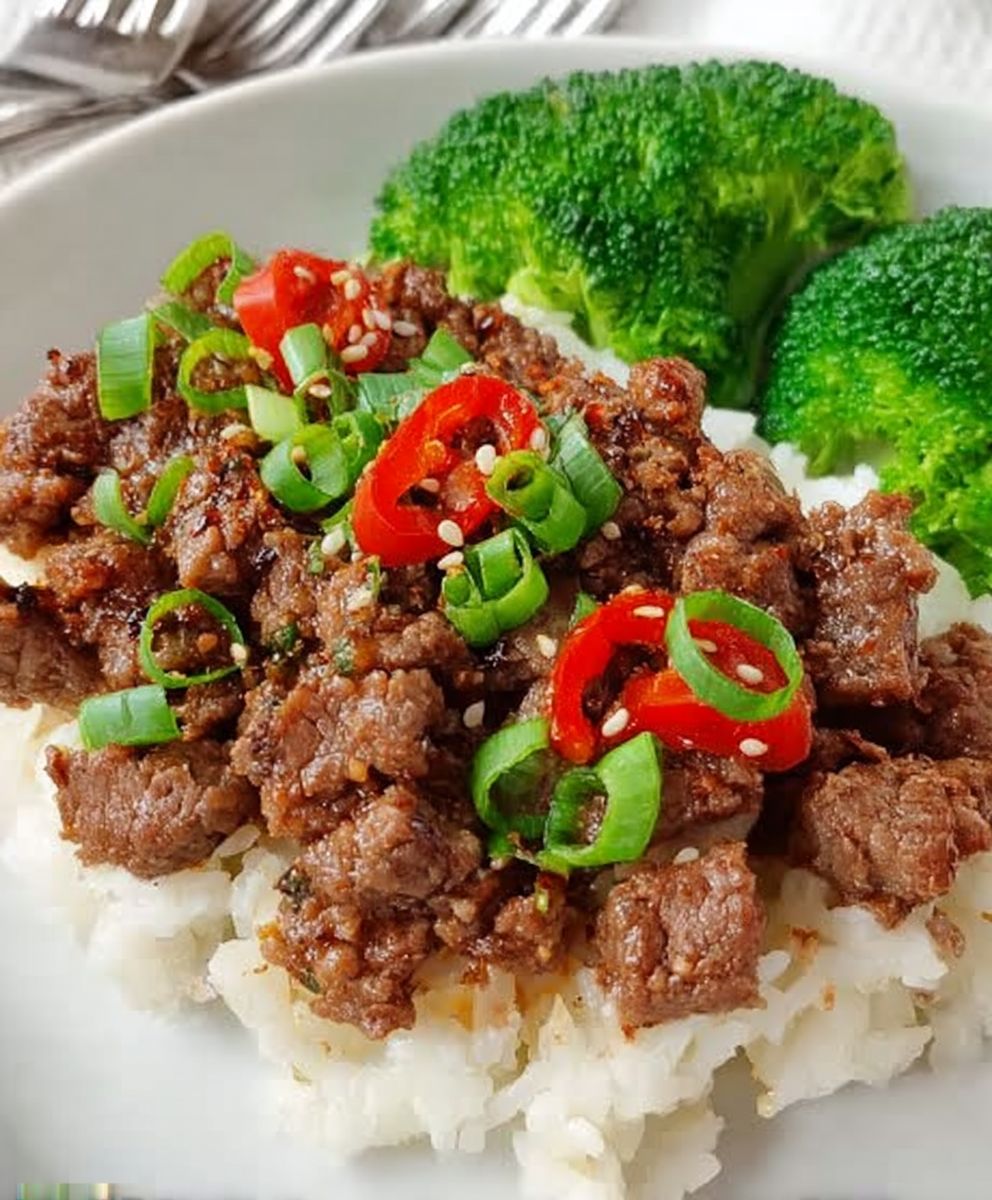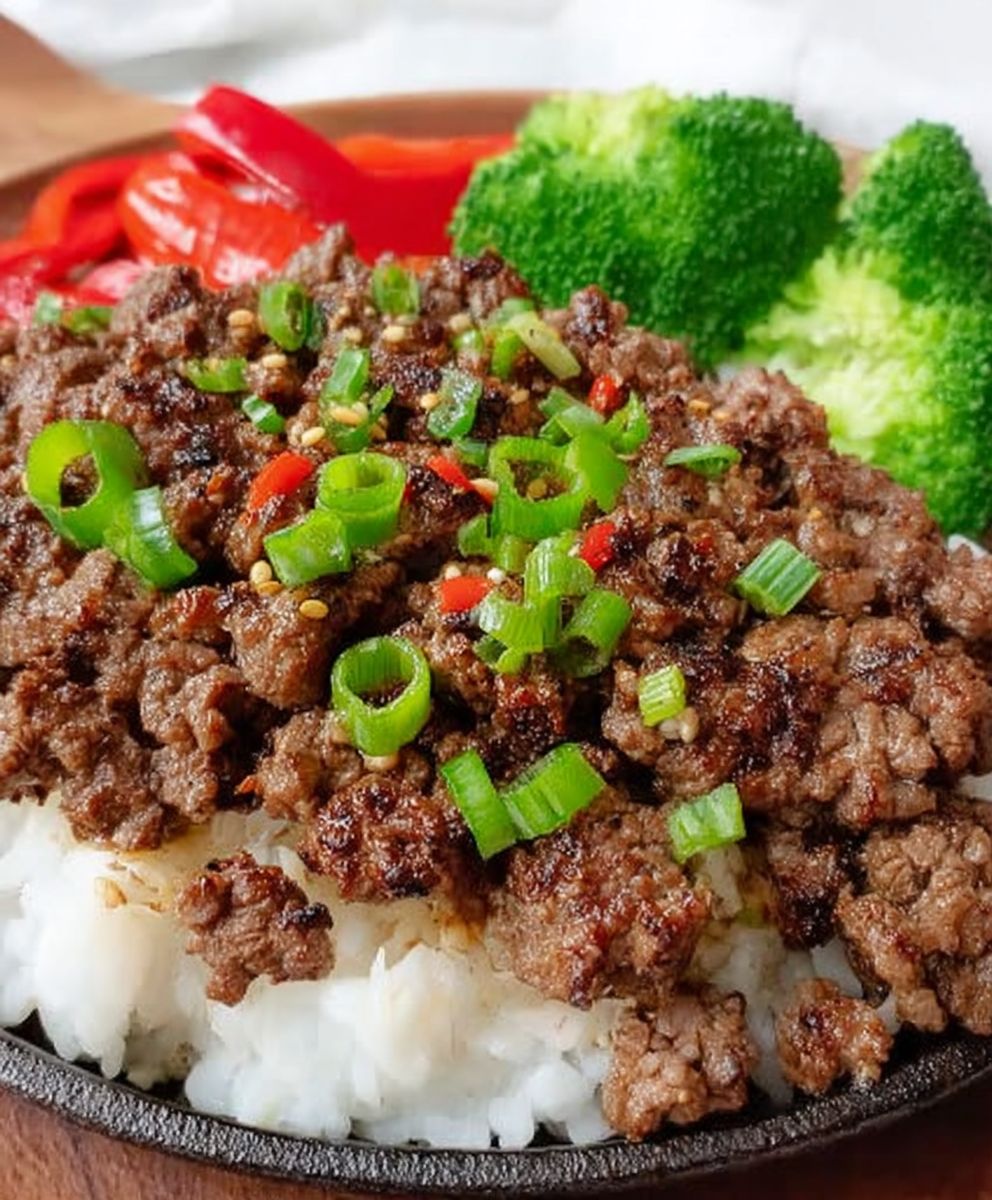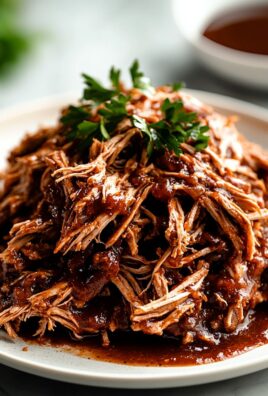Korean Beef, a symphony of savory, sweet, and umami flavors, is about to become your new weeknight dinner obsession. Imagine tender, thinly sliced beef, marinated in a tantalizing blend of soy sauce, garlic, ginger, and a touch of sweetness, then quickly seared to perfection. The aroma alone is enough to transport you to the bustling streets of Seoul, where this dish, often served as “Bulgogi,” is a beloved culinary staple.
Bulgogi, meaning “fire meat” in Korean, has a rich history dating back to the Goguryeo era (37 B.C. 668 A.D.), where it was originally enjoyed by the upper class. Over time, it evolved into a more accessible and widely enjoyed dish, becoming a symbol of Korean cuisine. What makes Korean Beef so irresistible? It’s the perfect balance of flavors the salty soy sauce, the pungent garlic, the warm ginger, and the subtle sweetness of brown sugar or honey all come together to create an unforgettable taste experience. Plus, the tender texture of the beef, achieved through careful slicing and marinating, melts in your mouth. But beyond the incredible taste, it’s also incredibly convenient. This recipe is quick to prepare, making it ideal for busy weeknights when you crave a delicious and satisfying meal without spending hours in the kitchen. Get ready to experience the magic of Korean Beef!
Ingredients:
- 1.5 lbs thinly sliced ribeye steak (or sirloin, flank steak)
- 1/2 cup soy sauce
- 1/4 cup brown sugar, packed
- 2 tablespoons sesame oil
- 2 tablespoons rice wine vinegar (or apple cider vinegar)
- 1 tablespoon minced garlic
- 1 tablespoon grated ginger
- 1/2 teaspoon black pepper
- 1/4 teaspoon red pepper flakes (optional, for a little heat)
- 1 medium onion, thinly sliced
- 2 green onions, thinly sliced, for garnish
- 1 tablespoon sesame seeds, for garnish
- Cooked rice, for serving
- Optional: Stir-fried vegetables (broccoli, carrots, bell peppers) for serving
Preparing the Marinade and Beef
- First, let’s get that delicious marinade going! In a medium-sized bowl, whisk together the soy sauce, brown sugar, sesame oil, rice wine vinegar, minced garlic, grated ginger, black pepper, and red pepper flakes (if using). Make sure the brown sugar is fully dissolved. This marinade is the key to that authentic Korean beef flavor.
- Now, prepare the beef. If your steak isn’t already thinly sliced, you’ll want to slice it against the grain into very thin strips, about 1/8 inch thick. This is crucial for tender and quick-cooking beef. Partially freezing the steak for about 30 minutes can make it easier to slice thinly.
- Place the thinly sliced beef into a large resealable bag or a shallow dish. Pour the marinade over the beef, ensuring that all the pieces are coated evenly. Add the thinly sliced onion to the bag or dish as well. The onion will infuse the beef with even more flavor.
- Seal the bag or cover the dish tightly and refrigerate for at least 30 minutes, or up to 4 hours. The longer it marinates, the more flavorful and tender the beef will become. However, don’t marinate it for longer than 4 hours, as the soy sauce can start to break down the beef too much, making it mushy.
Cooking the Korean Beef
- When you’re ready to cook, remove the beef from the refrigerator and let it sit at room temperature for about 15-20 minutes. This will help it cook more evenly.
- Heat a large skillet or wok over medium-high heat. Add a tablespoon of vegetable oil or sesame oil to the skillet. Make sure the skillet is nice and hot before adding the beef.
- Carefully add the marinated beef to the hot skillet in a single layer. Avoid overcrowding the skillet, as this will lower the temperature and cause the beef to steam instead of sear. If necessary, cook the beef in batches.
- Cook the beef for 2-3 minutes per side, or until it’s nicely browned and cooked through. The exact cooking time will depend on the thickness of your beef slices and the heat of your skillet. Keep a close eye on it to prevent it from overcooking and becoming tough.
- As the beef cooks, the marinade will thicken and create a delicious sauce. If the sauce becomes too thick or starts to burn, you can add a tablespoon or two of water to the skillet to thin it out.
- Once the beef is cooked through and the sauce has thickened, remove the skillet from the heat.
Serving and Garnishing
- Serve the Korean beef immediately over cooked rice. I like to use short-grain rice, but any type of rice will work.
- Garnish with the sliced green onions and sesame seeds. These add a pop of color and a nutty flavor.
- If you like, you can also serve the Korean beef with stir-fried vegetables. Broccoli, carrots, and bell peppers are all great choices. Simply stir-fry them in a little sesame oil until they’re tender-crisp.
- For an extra touch, you can add a fried egg on top of the rice and beef. The runny yolk adds richness and flavor.
Tips and Variations
- Spice it up: If you like your Korean beef with a little more heat, add an extra pinch of red pepper flakes to the marinade. You can also add a tablespoon of gochujang (Korean chili paste) for a deeper, more complex flavor.
- Sweeten it up: If you prefer a sweeter flavor, add an extra tablespoon of brown sugar to the marinade. You can also add a tablespoon of honey or maple syrup.
- Add some vegetables to the marinade: You can add other vegetables to the marinade, such as sliced mushrooms, shredded carrots, or chopped bell peppers. These will add extra flavor and nutrients to the beef.
- Use different cuts of beef: While ribeye is the most common cut of beef used for Korean beef, you can also use sirloin, flank steak, or even ground beef. If using ground beef, brown it in the skillet before adding the marinade.
- Make it in a slow cooker: For a hands-off approach, you can make Korean beef in a slow cooker. Simply combine all the ingredients in the slow cooker and cook on low for 6-8 hours, or on high for 3-4 hours. Shred the beef with two forks before serving.
- Make it ahead of time: Korean beef is a great make-ahead dish. You can marinate the beef for up to 24 hours in the refrigerator. You can also cook the beef ahead of time and reheat it when you’re ready to serve.
- Serving suggestions: Korean beef is delicious served over rice, but you can also serve it in lettuce wraps, tacos, or sandwiches. It’s also great as a topping for salads or noodles.
- Storage: Store leftover Korean beef in an airtight container in the refrigerator for up to 3 days. Reheat in a skillet or microwave.
Detailed Ingredient Notes
- Ribeye Steak: I highly recommend using ribeye steak for the best flavor and tenderness. The marbling in ribeye makes it incredibly juicy and flavorful. However, if you’re looking for a leaner option, sirloin or flank steak will also work well. Just be sure to slice them thinly against the grain.
- Soy Sauce: I prefer to use low-sodium soy sauce to control the saltiness of the dish. If you’re using regular soy sauce, you may want to reduce the amount slightly.
- Brown Sugar: Packed brown sugar adds sweetness and helps to caramelize the beef. You can use light or dark brown sugar, depending on your preference.
- Sesame Oil: Sesame oil is essential for that authentic Korean flavor. Be sure to use toasted sesame oil, which has a richer, nuttier flavor than regular sesame oil.
- Rice Wine Vinegar: Rice wine vinegar adds a touch of acidity to balance the sweetness of the brown sugar. If you don’t have rice wine vinegar, you can substitute apple cider vinegar or white vinegar.
- Garlic and Ginger: Freshly minced garlic and grated ginger are key to the flavor of the marinade. Don’t skimp on these ingredients!
- Black Pepper and Red Pepper Flakes: Black pepper adds a subtle warmth, while red pepper flakes add a touch of heat. Adjust the amount of red pepper flakes to your liking.
- Onion: Thinly sliced onion adds flavor and moisture to the beef. I prefer to use yellow onion, but white onion or even shallots will also work.
- Green Onions and Sesame Seeds: These are used for garnish and add a pop of color and flavor.
- Rice: Cooked rice is the perfect base for Korean beef. I like to use short-grain rice, but any type of rice will work.
Troubleshooting
- Beef is tough: If your beef is tough, it could be due to a few reasons. First, make sure you’re slicing the beef thinly against the grain. Second, don’t overcook the beef. It should only take a few minutes per side to cook through. Third, make sure you’re using a good quality cut of beef.
- Sauce is too thick: If the sauce becomes too thick, you can add a tablespoon or two of water to the skillet to thin it out.
- Sauce is too thin: If the sauce is too thin, you can simmer it for a few minutes longer to allow it to thicken. You can also add a cornstarch slurry (1 tablespoon cornstarch mixed with 2 tablespoons cold water) to the skillet to thicken the sauce.
- Beef is burning: If the beef is burning, lower the heat and add a tablespoon or two of water to the skillet.
- Not enough flavor: If you feel like the beef is lacking flavor, you can add more soy sauce, garlic, ginger, or sesame oil to the marinade. You can also add a tablespoon of gochujang (Korean chili paste) for a deeper, more complex flavor.
- 1.5 lbs thinly sliced ribeye steak (or sirloin, flank steak)
- 1/2 cup soy sauce
- 1/4 cup brown sugar, packed
- 2 tablespoons sesame oil
- 2 tablespoons rice wine vinegar (or apple cider vinegar)
- 1 tablespoon minced garlic
- 1 tablespoon grated ginger
- 1/2 teaspoon black pepper
- 1/4 teaspoon red pepper flakes (optional, for a little heat)
- 1 medium onion, thinly sliced
- 2 green onions, thinly sliced, for garnish
- 1 tablespoon sesame seeds, for garnish
- Cooked rice, for serving
- Optional: Stir-fried vegetables (broccoli, carrots, bell peppers) for serving
- Prepare the Marinade: In a medium bowl, whisk together soy sauce, brown sugar, sesame oil, rice wine vinegar, minced garlic, grated ginger, black pepper, and red pepper flakes (if using) until the brown sugar is dissolved.
- Prepare the Beef: If your steak isn’t already thinly sliced, slice it against the grain into very thin strips (about 1/8 inch thick). Partially freezing the steak for about 30 minutes can make it easier to slice.
- Marinate the Beef: Place the thinly sliced beef into a large resealable bag or shallow dish. Pour the marinade over the beef, ensuring all pieces are coated evenly. Add the thinly sliced onion.
- Refrigerate: Seal the bag or cover the dish tightly and refrigerate for at least 30 minutes, or up to 4 hours. Do not marinate longer than 4 hours.
- Rest: Remove the beef from the refrigerator and let it sit at room temperature for about 15-20 minutes.
- Cook the Beef: Heat a large skillet or wok over medium-high heat. Add a tablespoon of vegetable oil or sesame oil.
- Sear: Carefully add the marinated beef to the hot skillet in a single layer. Avoid overcrowding; cook in batches if necessary.
- Cook: Cook the beef for 2-3 minutes per side, or until nicely browned and cooked through. The marinade will thicken into a sauce. If the sauce becomes too thick or starts to burn, add a tablespoon or two of water to thin it out.
- Serve: Serve immediately over cooked rice. Garnish with sliced green onions and sesame seeds. Serve with stir-fried vegetables, if desired.
- Spice it up: Add an extra pinch of red pepper flakes or 1 tablespoon of gochujang to the marinade.
- Sweeten it up: Add an extra tablespoon of brown sugar, honey, or maple syrup to the marinade.
- Add vegetables to the marinade: Sliced mushrooms, shredded carrots, or chopped bell peppers can be added to the marinade.
- Use different cuts of beef: Sirloin, flank steak, or even ground beef can be used. Brown ground beef before adding the marinade.
- Slow Cooker: Combine all ingredients in a slow cooker and cook on low for 6-8 hours or on high for 3-4 hours. Shred the beef before serving.
- Make Ahead: Marinate the beef for up to 24 hours in the refrigerator. Cook the beef ahead of time and reheat when ready to serve.
- Serving Suggestions: Serve in lettuce wraps, tacos, or sandwiches, or as a topping for salads or noodles.
- Storage: Store leftovers in an airtight container in the refrigerator for up to 3 days. Reheat in a skillet or microwave.

Conclusion:
This isn’t just another recipe; it’s your new weeknight hero! The sweet and savory flavors of this Korean beef are simply irresistible, and the ease of preparation makes it a total winner. Seriously, from fridge to table in under 30 minutes? You can’t beat that! The tender beef, coated in that luscious, garlicky sauce, is a guaranteed crowd-pleaser, even for the pickiest eaters. I’ve made this countless times, and it’s always a hit.
But what truly elevates this dish is its versatility. While it’s fantastic served over a bed of fluffy white rice, don’t feel limited! For a lighter option, try serving it with quinoa or brown rice. Or, get creative and use it as a filling for lettuce wraps the crisp lettuce provides a delightful contrast to the rich beef. Another fantastic variation is to pile it high on steamed bao buns for a delicious and satisfying snack or appetizer.
And if you’re feeling adventurous, consider adding some heat! A pinch of red pepper flakes or a drizzle of sriracha will kick things up a notch. For a more subtle spice, try incorporating a small amount of gochujang (Korean chili paste) into the marinade. Just remember to adjust the amount to your personal preference.
Beyond the spice factor, you can also customize the vegetables. While I’ve kept it simple with just a garnish of sesame seeds and green onions, feel free to add some stir-fried vegetables like broccoli, bell peppers, or carrots. They’ll soak up the delicious sauce and add extra nutrients to your meal. You could even throw in some sliced mushrooms for an earthy flavor.
This Korean beef recipe is truly a blank canvas for your culinary creativity. Don’t be afraid to experiment and make it your own!
I’m confident that once you try this recipe, it will become a staple in your kitchen. It’s quick, easy, and incredibly flavorful the perfect combination for a busy weeknight meal. Plus, it’s a great way to introduce your family to the wonderful world of Korean cuisine.
So, what are you waiting for? Gather your ingredients, put on some music, and get cooking! I promise you won’t regret it. And most importantly, I want to hear about your experience! Did you try any variations? Did you add any extra ingredients? What did your family think?
Please, share your photos and comments below. I’m always eager to see how you’ve made this recipe your own. Let’s build a community of Korean beef enthusiasts! I can’t wait to see your creations and hear your feedback. Happy cooking! I hope you enjoy this recipe as much as I do. Don’t forget to rate the recipe and leave a comment below! Your feedback helps me improve and create even more delicious recipes for you.
Korean Beef: A Delicious and Easy Recipe You'll Love
Thinly sliced ribeye marinated in a savory-sweet sauce, quickly cooked to perfection, and served over rice. A classic Korean favorite!




